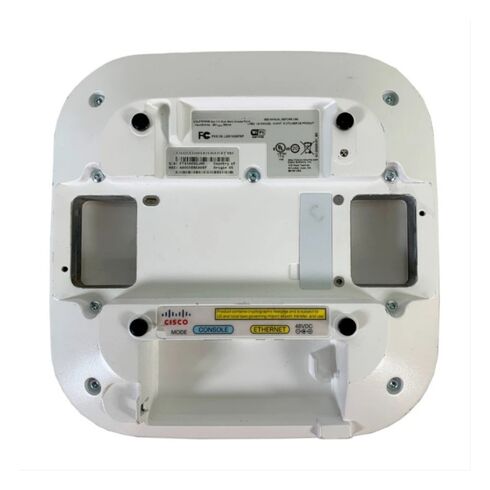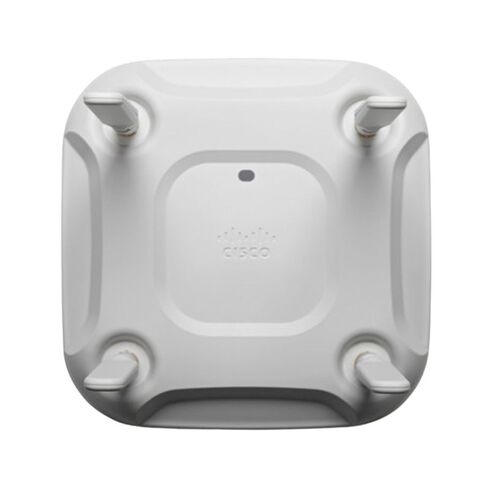AIR-CAP3702I-A-K9 Cisco 3702i 802.11ac Dual Band PoE+ Wireless Access Point
- — Free Ground Shipping
- — Min. 6-month Replacement Warranty
- — Genuine/Authentic Products
- — Easy Return and Exchange
- — Different Payment Methods
- — Best Price
- — We Guarantee Price Matching
- — Tax-Exempt Facilities
- — 24/7 Live Chat, Phone Support
- — Visa, MasterCard, Discover, and Amex
- — JCB, Diners Club, UnionPay
- — PayPal, ACH/Bank Transfer (11% Off)
- — Apple Pay, Amazon Pay, Google Pay
- — Buy Now, Pay Later - Affirm, Afterpay
- — GOV/EDU/Institutions PO's Accepted
- — Invoices
- — Deliver Anywhere
- — Express Delivery in the USA and Worldwide
- — Ship to -APO -FPO
- — For USA - Free Ground Shipping
- — Worldwide - from $30
Same product also available in:
| SKU/MPN | Warranty | Price | Condition | You save |
|---|---|---|---|---|
| AIR-CAP3702I-A-K9 | 1 Year Warranty | $285.00 | Factory-Sealed New Retail in Original Box (FSB) | You save: $99.75 (26%) |
| AIR-CAP3702I-A-K9 | 1 Year Warranty | $51.00 | Excellent Refurbished | You save: $17.85 (26%) |
Wireless Standard: 802.11ac
Introduction
The Cisco Aironet 3702i Wireless Access Point is equipped with the latest wireless standard, 802.11ac, which offers significant improvements over its predecessors. In this section, we will delve into the benefits and importance of this feature for users.
Overview of Cisco AIR-CAP3702I-A-K9
The Cisco AIR-CAP3702I-A-K9 is an advanced wireless access point from the renowned Aironet series, designed for high-performance networking in demanding environments.
Product Specifications
General Details
- Manufacturer: Cisco
- Model Number: AIR-CAP3702I-A-K9
- Series: Aironet 3700
- Type: Wireless Access Point
Technical Specifications
- Wireless Standard: IEEE 802.11ac
- Data Transfer Speed: 450 Mbps
- ISM Band Support: Yes
- UNII Band Support: Yes
- ISM Frequency Range: 2.41 GHz - 2.46 GHz
- UNII Frequency Range: 5.18 GHz - 5.83 GHz
Ports and Interfaces
Available Ports
- Ethernet Ports: Yes
- Fast Ethernet Port: Yes
- Gigabit Ethernet Port: Yes
- 10 Gigabit Ethernet Port: No
- 10/100/1000BASE-T: Auto-sensing (RJ-45)
- Management Console Port: Yes (RJ-45)
- Network Port (RJ-11): No
- PoE Port: No
- VGA: No
- HDMI: No
- Audio Line Out: No
- Serial Port: No
- USB: No
- Powerline: No
Memory and Power
Memory Specifications
- DRAM: 512 MB
- Flash Memory: 64 MB
Power Requirements
- Input Voltage: 110 V AC, 220 V AC
- Power Source: Power Supply, PoE+
Antenna and Environmental Conditions
Antenna Features
- 2.4 GHz Antenna: 4 dBi gain, internal omni, 360° horizontal beamwidth
- 5 GHz Antenna: 4 dBi gain, internal omni, 360° horizontal beamwidth
Environmental Specifications
- Storage Temperature: -22 to 158°F / -30 to 70°C
- Storage Altitude Test: 77°F / 25°C, 15,000 ft / 4,572 m
- Operating Temperature: 32 to 104°F / 0 to 40°C
- Operating Humidity: 10 to 90% (non-condensing)
- Operating Altitude Test: 104°F / 40°C, 9,843 ft / 3,000 m
Improved Speed and Bandwidth
Enhanced Data Transfer Rates
One of the primary advantages of 802.11ac is its ability to provide faster data transfer rates compared to previous standards. With support for multi-user MIMO (Multiple Input Multiple Output) technology, this access point can transmit data to multiple devices simultaneously, resulting in increased speed and efficiency.
Increased Bandwidth Capacity
Another notable benefit of 802.11ac is its expanded bandwidth capacity. This standard operates on the 5GHz frequency band, which is less crowded than the 2.4GHz band used by older standards such as 802.11n. By utilizing this less congested spectrum, users can enjoy higher data throughput and experience a smoother wireless connection.
Extended Range and Coverage
Beamforming Technology
802.11ac incorporates beamforming technology, which enables the access point to focus its wireless signal directly towards connected devices. This targeted approach enhances signal strength and extends the range of the wireless network. As a result, users can enjoy reliable connectivity even in larger spaces or areas with obstacles such as walls or furniture.
Improved Signal Quality
In addition to extending the range, 802.11ac also enhances signal quality. This standard utilizes advanced modulation techniques like 256-QAM (Quadrature Amplitude Modulation), which increases the number of bits transmitted per symbol. This higher modulation ensures greater data integrity, minimizing packet loss and reducing the likelihood of signal degradation over distance.
Seamless HD Video Streaming and Gaming
Support for High-Bandwidth Applications
With its improved speed and bandwidth capacity, 802.11ac is ideal for bandwidth-intensive applications such as HD video streaming and online gaming. Users can enjoy uninterrupted streaming of high-definition content and engage in lag-free gaming experiences, even when multiple devices are connected to the network simultaneously.
Reduced Latency
802.11ac significantly reduces latency, ensuring a more responsive connection for real-time applications like video conferencing or online gaming. The low latency achieved by this standard allows for smooth and seamless communication, minimizing delays and improving overall user experience.
Frequency Band: Dual Band
Introduction
The Cisco Aironet 3702i Wireless Access Point operates on a dual-band frequency, offering users the flexibility to choose between two different frequency ranges. Let's explore the benefits and importance of this feature in more detail.
Enhanced Network Capacity
Simultaneous Operation on Multiple Bands
The dual-band capability of this access point allows it to operate simultaneously on both the 2.4GHz and 5GHz bands. This means that users can connect their devices to either band, depending on their specific needs. By distributing devices across the two bands, network capacity is effectively increased, reducing congestion and improving overall performance.
Compatibility with Legacy Devices
The 2.4GHz band is supported by older wireless standards, making it compatible with a wide range of legacy devices that may not support the newer 5GHz band. By offering dual-band functionality, this access point ensures that all devices can connect to the network regardless of their compatibility, providing a seamless and inclusive user experience.
Minimized Interference and Improved Performance
Reduced Interference in the 5GHz Band
The 5GHz band used by this access point is generally less crowded than the 2.4GHz band, which is prone to interference from other wireless devices such as microwaves or cordless phones. By utilizing the 5GHz band, users can avoid these sources of interference and enjoy a more stable and reliable wireless connection.
Better Performance in High-Density Environments
In high-density environments such as offices or apartment buildings, the 2.4GHz band can become congested due to the large number of devices operating on that frequency. The 5GHz band offers additional channels and wider bandwidth, allowing for better performance in such environments. This ensures that users can maintain a fast and stable connection even when surrounded by numerous other wireless networks.
Optimized Device Selection
Choosing the Appropriate Band for Each Device
With dual-band capability, users can select the most suitable band for each of their devices based on their specific requirements. Devices that prioritize range over speed, such as IoT devices or smart home appliances, can be connected to the 2.4GHz band for better coverage. On the other hand, devices that demand higher data transfer rates, like laptops or smartphones, can connect to the faster and less congested 5GHz band.
Seamless Roaming between Bands
Dual-band support also enables seamless roaming between the 2.4GHz and 5GHz bands. As users move around their home or office space, their devices can automatically switch between bands to maintain a stable connection. This ensures that users experience minimal disruptions while moving from one area to another.
Power Over Ethernet: PoE+
Introduction
The Cisco Aironet 3702i Wireless Access Point supports Power Over Ethernet (PoE+), allowing it to receive power and data through a single Ethernet cable. Let's explore the benefits and importance of this feature for users.
Simplified Installation and Flexibility
Single Cable Solution
With PoE+, users no longer need to install separate power cables for their access points. The access point can draw both power and data from the Ethernet cable, simplifying the installation process and reducing cable clutter. This makes it easier to deploy the access point in areas where power outlets may be limited or inaccessible.
Flexible Placement
The ability to power the access point through an Ethernet cable provides greater flexibility in terms of device placement. Users can position the access point in optimal locations for maximum coverage without being limited by the availability of power outlets. This allows for better signal distribution and improved wireless performance across the desired area.
Cost and Energy Efficiency
Reduced Infrastructure Costs
By eliminating the need for additional power cables and outlets, PoE+ reduces infrastructure costs. This is particularly beneficial in larger deployments where multiple access points are required. The cost savings achieved through PoE+ can be significant, making it an attractive solution for businesses and organizations seeking to minimize expenses.
Energy Conservation
PoE+ also promotes energy conservation by enabling centralized power management. With the ability to remotely control each access point's power status, administrators can easily turn off or schedule power cycles for devices that are not in use. This helps reduce energy consumption, contributing to a greener and more sustainable network infrastructure.
Improved Reliability and Redundancy
Uninterrupted Power Supply
PoE+ ensures a reliable power supply to the access point, even during power outages. By utilizing an Uninterruptible Power Supply (UPS) or backup power source, users can keep their wireless network operational during unforeseen circumstances. This is especially crucial for businesses or organizations where continuous connectivity is mission-critical.
Centralized Power Management
With PoE+, administrators have centralized control over power management. This allows for efficient monitoring and troubleshooting of power-related issues. By quickly identifying and resolving power-related problems, network downtime can be minimized, ensuring uninterrupted connectivity for users.
Part Number: AIR-CAP3702I-A-K9
Introduction
The Cisco Aironet 3702i Wireless Access Point's part number, AIR-CAP3702I-A-K9, is a unique identifier for this specific model. In this section, we will discuss the benefits and importance of this feature for users.
Easy Identification and Compatibility
Clear Identification
The part number, AIR-CAP3702I-A-K9, serves as an easy way to identify the specific model of the access point. This is especially useful when ordering or replacing equipment, as it ensures that users receive the correct product.
Compatibility with Cisco Systems
The part number also indicates that the access point is manufactured by Cisco Systems, a renowned and trusted provider of networking solutions. This guarantees compatibility with other Cisco networking equipment, allowing for seamless integration into existing network infrastructures.
Product Differentiation and Feature Set
Distinguishing Features
The part number can also provide information about specific features or variations within a product line. In the case of AIR-CAP3702I-A-K9, it denotes that this access point is an indoor model with integrated antennas and supports the 802.11ac wireless standard. This allows users to easily differentiate between various models and select the one that best suits their requirements.
Additional Features and Capabilities
While the part number alone may not provide an exhaustive list of features, it serves as a starting point for understanding the capabilities of the access point. Users can refer to the product documentation or consult with Cisco representatives to learn more about the specific features and functionalities offered by AIR-CAP3702I-A-K9.
Warranty and Support
Warranty Coverage
The part number is often associated with warranty information, indicating the duration and terms of coverage provided by Cisco for the access point. This ensures that users can enjoy peace of mind knowing that their investment is protected against manufacturing defects or malfunctions during the specified warranty period.
Technical Support
By referencing the part number, users can easily access technical support resources specific to their model. This includes documentation, firmware updates, and online forums where they can seek assistance from Cisco experts or engage with a community of fellow users. Having access to comprehensive technical support enhances the overall user experience and ensures prompt resolution of any issues that may arise.













